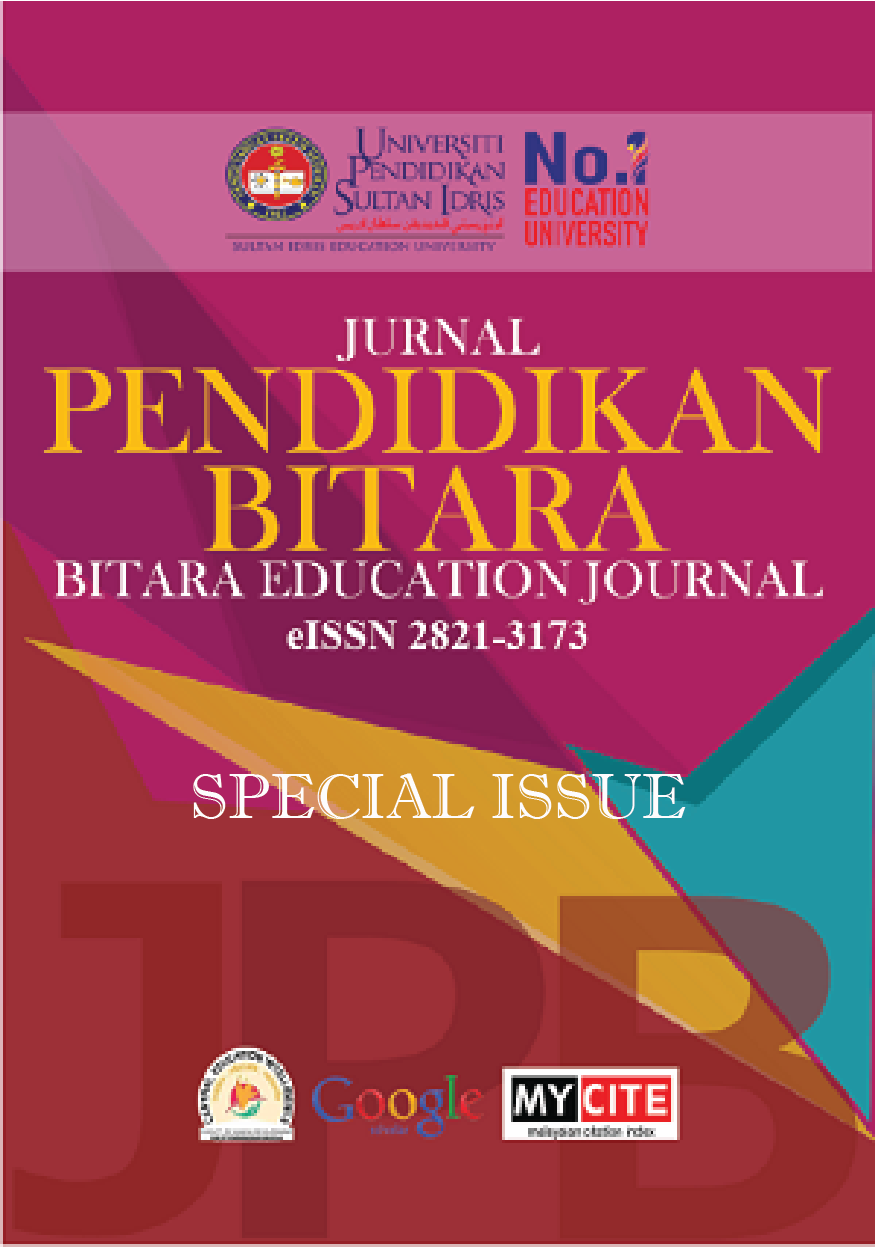Implementation of Best Practices in Malay Teaching (ATP) Based on the Zemelman Model among reschool Teachers
Pelaksanaan amalan terbaik Pengajaran (ATP) Bahasa Melayu oleh guru prasekolah berasaskan Model Zemelman dalam Pengajaran Bahasa Melayu
DOI:
https://doi.org/10.37134/bitara.vol16.sp2.17.2023Keywords:
Best Practices of Teaching, Malay Language, Preschool TeachersAbstract
This study was conducted to identify the implementation of Best Teaching Practices (ATP) among preschool teachers. This study aims to explore the implementation of preschool teacher ATP based on one of the three main principles of ATP stated by Zemelman (2012), which is pupil-centered teaching.In this study, the four basic elements of pupil-centered teaching focuse on are student experience-based teaching, holistic teaching, authentic teaching, and challenge- based teaching. Data was obtained by applying triangulation techniques, namely through a combination of interview, observation, and document analysis methods, on three preschool teachers selected as respondents to this study. This method was carried out on all three respondents to collect information on four basic elements related to pupil-centered teaching, which consist of the teacher's views on ATP. Feedback from all respondents was translated and analyzed according to the theme. The findings showed that preschool teachers have a positive view of the implementation of ATP. Preschool teachers also face challenges in implementing ATP, such as time constraints, insufficient knowledge, and limited facilities. Preschool teachers have contributed several suggestions to overcome all the challenges that arise such as: i) training and courses and preparation of teaching aids.
Downloads
References
Abdul Halim Masnan, Nur Ellina Anthony & Nur Arifah Syahindah Zainudin, 2019 (2019).Pengetahuan pengajaran dalam kalangan guru prasekolah. Jurnal Pendidikan AwalKanak- Kanak Kebangsaan, 8, 33-41
Abdullah Hassan. (2004). Language planning in Malaysia: The first hundred years. English Today, 84. 3-12. Abdullah Hassan dan Ainon Mohd. (2008). Bakat dan kemahiran memimpin. Kuala Lumpur: PTS Profesional.
Ambotang, A. S., & Mohd Hashim, M. H. (2010). The Relation of Work Environment and Stress in Classroom Management among Preschool Teachers. Journal of Techno-Social, 2(2). Retrieved from https://penerbit.uthm.edu.my/ojs/index.php/JTS/article/view/326
Chuanmei Dong (2018) Preschool teachers’ perceptions and pedagogical practices: youngchildren’s use of ICT, Early Child Development and Care, 188(6), 635-650
Creswell, J. W. (2012). Educational Research (Planning, Conduction and EvaluatingQuantitative and Qualitative Research) (4th Ed). Boston: Pearson.
Creswell, J.W. (2014). Research Design: Qualitative, Quantitative and Mixed MethodsApproaches. Los Angeles: SAGE Publications. Merriam, S. B. (2009). Qualitative Research A Guide to Design and Implementation (2nd Ed). San Francisco: Jossey-Bass.
Hushaini, N. H., Osman, Z., & Sarudin, A. (2020). Pelaksanaan Amalan Terbaik Pengajaran Bahasa Melayu Dalam Kalangan Guru Sekolah Rendah (The Implementation Of Best Teaching Practices Of Malay Language Among Primary School Teachers). Jurnal Pendidikan Bahasa Melayu, 10(1), 1-13.
Juriah Long. (2010). Kaedah pengajaran dan pembelajaran Bahasa Melayu (Pnyt.). Bangi: Penerbit Universiti Kebangsaan Malaysia.
Kementerian Pendidikan Malaysia (a). 2017. Dokumen Standard dan Penaksiran Kebangsaan (Pendidikan Prasekolah).
Miles, M. B., & Huberman, A. M. (1994). An Expanded Sourcebook Qualitative DataAnalysis (2nd Ed). Sage Publications, Inc.
Nordin, N., Ahmad Sabri, M. S., Nurdin, J., Rossli, N. N., & Zulkuple, S. S., (2022). Analisis Keperluan Latihan Pembangunan Profesionalisme Guru Tadika Islam Berdasarkan Perspektif Guru. Jurnal Penyelidikan Sains Sosial (JOSSR), 5(16), 1 - 8.
Nyumba, T.O., Wilson, K., Derrick, C. J., & Mukherjee, N., (2018). The use of focus groupdiscussion methodology: Insights from two decades of application in conservation.Retrieved from https://besjournals.onlinelibrary.wiley.com/doi/10.1111/2041210X.12860
Sharifah Nor Puteh & Aliza Ali. (2011). Pendekatan bermain dalam pengajaran bahasa dan literasi bagi pendidikan Prasekolah. Jurnal Pendidikan Bahasa Melayu, 1 (2): 1- 15.
Shahril @ Charil Haji Marzuki. (2004). Amalan pengajaran guru yang berkesan: Kajian di beberapa sekolah menengah di Wilayah Persekutuan dan Selangor. Jurnal Pendidikan, 24: 1-14
Wan Nurzuliana Wan Ahmad. (2019). Amalan guru dalam melaksanakan kemahiran literasi Bahasa Melayu bagi Program Linus di sekolah rendah. Jurnal Pendidikan Bahasa Melayu, 9 (1): 1- 11.
Zdanevych L.V, Kruty K.L, Tsehelnyk T.M, Pisotska L.S, & Kazakova N.V. (2020). TheFormation of Key Competences in the Training Process of Preschool EducationSpecialists (Experience of the United Kingdom, Germany, Ukraine). InternationalJournal of Higher Education. 9(7). 196-206.
Zemelman, S., Daniels, H. & Hyde, A. (2012). Best practice bringing standard to life in America’s Classroom. Ansterdam: Hanover Street Heinem. Zulkifli Osman. 2013. Belajar bahasa secara holistik: Apakah pandangan murid? Jurnal Bahasa dan Sastra, 13 (2): 102-1
Downloads
Published
How to Cite
Issue
Section
License
Copyright (c) 2023 Shuhaiza Mohd Sharif, Abdul Halim Masnan

This work is licensed under a Creative Commons Attribution-NonCommercial-ShareAlike 4.0 International License.





